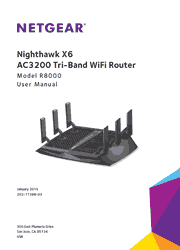There’s never been WiFi like it. The Nighthawk X6 AC3200 Router with breakthrough Tri-Band WiFi technology was built to connect to each and every device in your home—automatically and simultaneously. Laptops, tablets, phones, TVs, game consoles, music streamers, cameras – if it’s WiFi enabled, it’s X6 accelerated. With a massive combined wireless speed of up to 3.2Gbps, 3 WiFi bands and Smart Connect intelligence, every device is assigned the fastest WiFi connection possible and optimized for maximum speed.
1. Hardware Setup
Extend the Antennas
Top View
Rear Panel
Position Your Router
Cable Your Router
2. Connect to the Network and Access the Router
Wired Connection
WiFi Connection
Label
Types of Logins
Use an Internet Browser to Access the Router
Change the Language
Access the Router with NETGEAR genie Apps
3. Specify Your Internet Settings
Specify an Internet Connection Without a Login
Specify an Internet Connection That Uses a Login
Specify IPv6 Internet Connections
Change the MTU Size
Enable the Bridge or Add a VLAN Tag Group
4. Optimize Performance
Wi-Fi Multimedia Quality of Service
5. Control Access to the Internet
Allow or Block Access to Your Network
Use Keywords to Block Internet Sites
Block Services from the Internet
Schedule When to Block Internet Sites and Services
Avoid Blocking on a Trusted Computer
Set Up Security Event Email Notifications
6. Tri-Band WiFi Connections
How Tri-Band WiFi Improves Speed and Performance
Load Balancing
Benefits of Tri-Band WiFi
Smart Connect
Beamforming
7. Share USB Devices Attached to the Router
Access a USB Device on the Network
Back Up Windows Computers with ReadySHARE Vault
Back Up Mac Computers with Time Machine
Control Access to the USB Device
Add a Network Folder on a USB Device
Edit a Network Folder on a USB Device
Approve USB Devices
8. Access USB Devices Through the Internet
Set Up FTP Access Through the Internet
Access USB Devices Through the Internet with FTP
Dynamic DNS
Your Personal FTP Server
Set Up Your Personal FTP Server
9. Use the Router as a Media Server
Play Media from a USB Device on TiVo
10. Share a USB Printer
Download the ReadySHARE Printer Utility
Install the ReadySHARE Printer Utility
Use the Shared Printer
View or Change the Status of a Printer
Use the Scan Feature of a Multifunction USB Printer
Change NETGEAR USB Control Center Settings
11. Network Settings
Set Up a Default DMZ Server
Change the Router’s Device Name
Change the LAN TCP/IP Settings
Specify the IP Addresses That the Router Assigns
Disable the DHCP Server Feature in the Router
Reserve LAN IP Addresses
Use the WPS Wizard for WiFi Connections
Specify Basic WiFi Settings
Change the WiFi Password or Security Level
Set Up a Guest Network
Control the Wireless Radios
Set Up a Wireless Schedule
Specify WPS Settings
12. Manage Your Network
View Router Status
View and Manage Logs of Router Activity
Monitor Internet Traffic
Custom Static Routes
View Devices Currently on the Network
Manage the Router Configuration File
Remote Management
Configure the LEDs
13. Use VPN to Access Your Network
Install OpenVPN Software on Your Computer
Use VPN to Access the Router’s USB Device and Media
Use VPN to Access Your Internet Service at Home
14. Specify Internet Port Settings
Add a Custom Port Forwarding Service
Edit a Port Forwarding Service
Delete a Port Forwarding Entry
Application Example: Make a Local Web Server Public
Set Up Port Triggering
15. Troubleshooting
Sequence to Restart Your Network
Check Ethernet Cable Connections
Wireless Settings
Network Settings
Standard LED Behavior When the Router is Powered On
Power LED Is Off or Blinking
Power LED Stays Amber
LEDs Never Turn Off
Internet or Ethernet Port LEDs Are Off
WiFi LED Is Off
Cannot Log In to the Router
Cannot Access the Internet
Changes Not Saved
Wireless Connectivity
Troubleshoot Your Network Using the Ping Utility
